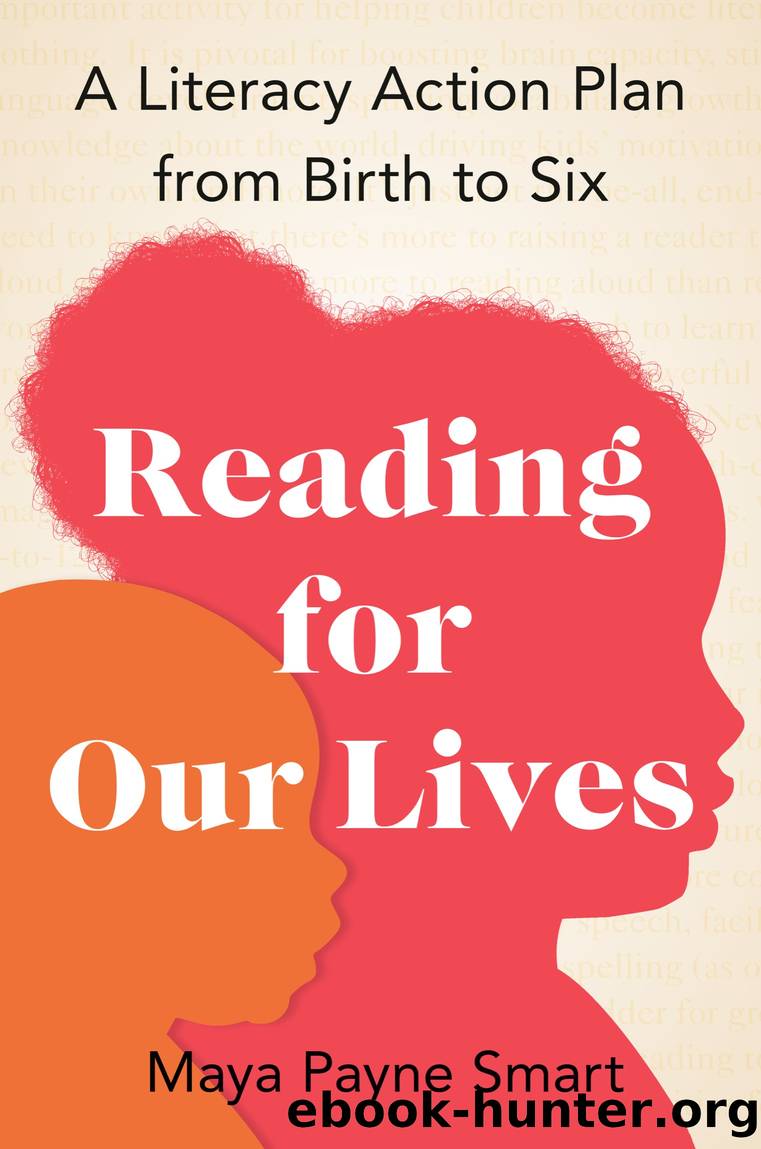Reading for Our Lives by Maya Payne Smart

Author:Maya Payne Smart [Smart, Maya Payne]
Language: eng
Format: epub
Publisher: Penguin Publishing Group
Published: 2022-08-02T00:00:00+00:00
Teaching Letter Names the Smart Way
As readers ourselves, parents often fail to grasp what a leap it is even to see letters as distinct from other images and graphics in print. To know an O from a circle or an H from a stick figure is the result of a long learning process, a slow-growing awareness of print and its properties. At first, pictures, letters, and numbers are all a bunch of 2D marks to be deciphered.
Parents with savvy and resources, though, tend to use a wide range of activities and contexts at home to build and reinforce alphabetic skills. They play with magnetic letters, point out letters on household items, read alphabet books, and talk about the letters in their childâs name. In questionnaires, in-the-know parents reported using an average of fourteen out of eighteen different home-teaching contexts, from storybooks and shopping lists to letter blocks and flash cards, to engage kids with the alphabet. Brief teachable moments pave the way.
Unsurprisingly, the parents who reported teaching the ABCs the most frequently tended to be those with high expectations of what their kids should know before first grade. These parents had wisely linked the letter work they did with future school achievement. And you can do the same.
What you say to your children about letter shapes, names, and soundsâand whenâmatters. When you take responsibility for teaching your kids the alphabet before they start kindergarten, youâre doing crucial work to support their later success. Speak with knowledge and intention, seize everyday moments, and structure your home and schedule to support deliberate learning. Here are a few ideas to get you started.
CALL LETTERS BY THEIR NAMES. While some people prefer to teach letter sounds before letter names, the fact of the matter is that kids need to know bothâand instruction is simpler when you have unique and consistent labels. I say teach both at the same time. âClearly, it is easier to say, âPoint to the A,â than to say, âPoint to the letter that says /æ/ (or /ä/ or /Ä/ or /uh/),âââ pioneering researcher Marilyn Jager Adams explains.
Think of the names as labeled buckets in which kids collect all their encounters with a letterâuppercase, lowercase, print, cursive, its various sounds, and so on. Over time and through exposure, in oneâs memory, âthe label provides a means of bonding together all of oneâs experiences with a to-be-learned concept,â Adams writes. âIn doing so, it can only hasten the recognition of the similarities of the concept across its occurrences.â
Recent research continues to provide support for using letter names. Studies suggest that letter-name knowledge benefits young childrenâs spelling, for exampleâa crucial component of literacy development. And researchers have found evidence that combining letter-name training with letter-sound instruction accelerates letter-sound learning.
Parentsâ talk about letters and use of letter names can start at any time but becomes particularly powerful when kids are 3 years old and can focus on letters in print. At that point, they can begin to forge letter identities through repeated experience with their shapes, names, and sounds.
Download
This site does not store any files on its server. We only index and link to content provided by other sites. Please contact the content providers to delete copyright contents if any and email us, we'll remove relevant links or contents immediately.
| Administration | Assessment |
| Educational Psychology | Experimental Methods |
| History | Language Experience Approach |
| Philosophy & Social Aspects | Reform & Policy |
| Research |
The Art of Coaching Workbook by Elena Aguilar(50166)
Trainspotting by Irvine Welsh(21075)
Twilight of the Idols With the Antichrist and Ecce Homo by Friedrich Nietzsche(18322)
Fangirl by Rainbow Rowell(8817)
Periodization Training for Sports by Tudor Bompa(7945)
Change Your Questions, Change Your Life by Marilee Adams(7404)
This Is How You Lose Her by Junot Diaz(6475)
Asking the Right Questions: A Guide to Critical Thinking by M. Neil Browne & Stuart M. Keeley(5384)
Grit by Angela Duckworth(5321)
Red Sparrow by Jason Matthews(5223)
Paper Towns by Green John(4825)
Room 212 by Kate Stewart(4766)
Ken Follett - World without end by Ken Follett(4466)
The Sports Rules Book by Human Kinetics(4095)
Housekeeping by Marilynne Robinson(4083)
Double Down (Diary of a Wimpy Kid Book 11) by Jeff Kinney(3955)
Papillon (English) by Henri Charrière(3942)
The Motorcycle Diaries by Ernesto Che Guevara(3803)
Exercise Technique Manual for Resistance Training by National Strength & Conditioning Association(3798)
